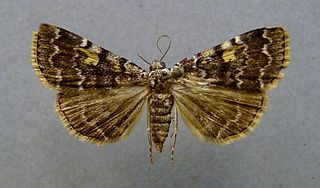| Euselasiinae | |
|---|---|
 | |
| Hades noctula White-rayed metalmark, Costa Rica | |
| Scientific classification | |
| Kingdom: | |
| Phylum: | |
| Class: | |
| Order: | |
| Family: | |
| Subfamily: | Euselasiinae |
Euselasiinae is a subfamily of Riodinidae. The species are confined to the Neotropical realm.
| Euselasiinae | |
|---|---|
 | |
| Hades noctula White-rayed metalmark, Costa Rica | |
| Scientific classification | |
| Kingdom: | |
| Phylum: | |
| Class: | |
| Order: | |
| Family: | |
| Subfamily: | Euselasiinae |
Euselasiinae is a subfamily of Riodinidae. The species are confined to the Neotropical realm.
From Funet [1]

Ypsolophidae is a family of moths with some 160 species. They are included in the Plutellidae by many authors.

Riodinidae is the family of metalmark butterflies. The common name "metalmarks" refers to the small, metallic-looking spots commonly found on their wings. The 1532 species are placed in 146 genera. Although mostly Neotropical in distribution, the family is also represented both in the Nearctic, Palearctic, Australasian (Dicallaneura), Afrotropic, and Indomalayan realms.

The large chequered skipper is a butterfly of the family Hesperiidae. It is the single member of the monotypic genus Heteropterus. The species can be found in isolated populations in Europe and east across the Palearctic to Central Asia and Korea. It is endangered in the Netherlands.

Plecotus is a genus of vesper bat, commonly called long-eared bats. They are found throughout Eurasia and northern Africa. Many species in the genus have only been described and recognized in recent years.

Lycaena is a genus of butterflies. The genus range is Holarctic, with the exception of four species found in New Zealand, two in South Africa, one in New Guinea and one in Java. It is commonly divided into several subgenera, such as Antipodolycaena. Many formerly independent genera are now subsumed within Lycaena; the genus Gaiedes may also belong here. Many of the subgenera, species groups and species listed here may be synonyms.
Atrophaneura luchti is a species of butterfly in the family Papilionidae. It is endemic to Indonesia (Java).

Udea fulvalis is a species of moth of the family Crambidae. It was first described by Jacob Hübner in 1809.

Xestia baja, the dotted clay, is a species of moth of the family Noctuidae. It is found in Europe, Turkey, northern Iran, Transcaucasia, the Caucasus, central Asia, Siberia, Mongolia, Tibet, China, Korea and Japan.

The brown rustic is a species of moth of the family Noctuidae. It is found in Europe. then East across the Palearctic to the Sayan Mountains in Central Asia.

Aplocera praeformata, known as the purple treble-bar, is a species of moth in the family Geometridae.

Idia calvaria is a species of litter moth of the family Erebidae. It is found in Central France and northern and central Central Europe, but mostly in the surroundings of the Mediterranean Sea. It is also present in Turkey, the Caucasus and Anatolia.

Gegenes pumilio, the pigmy skipper or dark Hottentot, is a butterfly of the family Hesperiidae. It is found from the coasts of the Mediterranean Sea through Anatolia to the Himalaya and south in the whole of Africa.

Larisa is a genus of moths belonging to the subfamily Olethreutinae of the family Tortricidae. It contains only one species, Larisa subsolana, which is found in North America, where it has been recorded from Alabama, Florida, Georgia, Illinois, Indiana, Kentucky, Maine, Maryland, Massachusetts, Minnesota, Mississippi, Missouri, New York, Ohio, Oklahoma, Ontario, Quebec, South Carolina, Tennessee, Texas, Virginia, and West Virginia.

Epinotia cruciana, the willow tortrix, is a moth of the family Tortricidae.

Pachliopta kotzebuea, the pink rose, is a butterfly of the family Papilionidae. It is found in the Philippines.

Synemon is a genus of moths within the family Castniidae. It was described by Edward Doubleday in 1846. The genus contains 24 described and 20 undescribed species.

The triangle is a species of moth of the family Limacodidae. It is found in most of the Palearctic realm. The wingspan is 15–20 mm. Adults are on wing from the end of May to mid July in one generation per year.

Psilocorsis quercicella is a species of moth of the family Depressariidae. It is found in the United States, including Florida, Maryland, Massachusetts and Oklahoma.

Phalonidia gilvicomana, the wall-lettuce conch, is a species of moth of the family Tortricidae. It is found in most of Europe. The habitat consists of woodlands, downlands and waste grounds.

Nemeobiinae is a subfamily of Riodinidae, the metalmark family. The subfamily's members consist entirely of Old World members of the Riodinid family. Recent revisions to the subfamily have began to include members located within the New World as well, however, the subfamily continues to encompass the entirety of the Old World Riodinids.